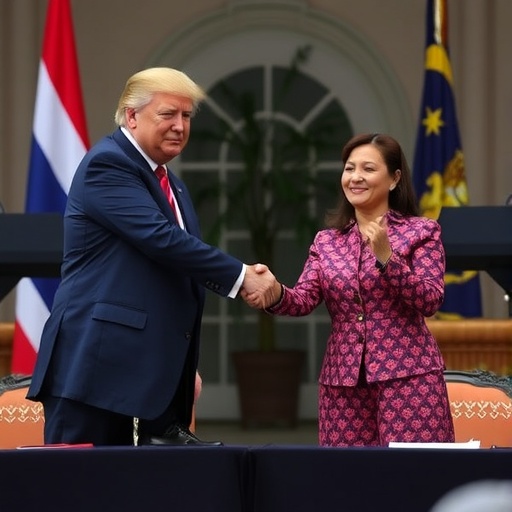Trump Co-Signs Landmark Ceasefire Between Thailand and Cambodia in Malaysia: A Diplomatic Breakthrough After Border Bloodshed
In a stunning turn of international diplomacy, U.S. President Donald Trump has co-signed a ceasefire agreement between Thailand and Cambodia, brokered in Malaysia’s bustling capital of Kuala Lumpur. This historic pact comes on the heels of a brutal border dispute that claimed over 50 lives and displaced thousands, signaling a potential end to decades of simmering tensions in Southeast Asia. Trump‘s unexpected involvement, marked by his signature alongside Thai Prime Minister Srettha Thavisin and Cambodian leader Hun Manet, underscores a bold U.S. push into regional affairs, aiming to stabilize an area critical to global trade routes.
The agreement, finalized late Wednesday after marathon talks, includes the immediate release of 18 Cambodian prisoners of war held by Thai forces and establishes a joint monitoring committee to prevent future violations. As Trump put it during the signing ceremony, “We’re bringing peace where there was chaos—America first means peace for our allies too.” This move not only highlights Trump’s personal brand of deal-making but also raises questions about the long-term impact on U.S. influence in Asia amid rising powers like China.
The Fiery Border Skirmishes That Ignited the Crisis
The roots of this ceasefire trace back to early 2023, when a long-dormant border dispute over the Preah Vihear temple complex erupted into open conflict. Located on a rugged hilltop straddling the Thai-Cambodian frontier, the 11th-century Khmer temple has been a flashpoint since a 1962 International Court of Justice ruling awarded it to Cambodia, a decision Thailand has contested ever since. Tensions boiled over last month when Thai troops clashed with Cambodian patrols, resulting in a firefight that killed 32 soldiers and civilians combined, according to reports from the United Nations Office for the Coordination of Humanitarian Affairs (OCHA).
Statistics paint a grim picture: Over 5,000 civilians were displaced from border villages, with agricultural lands—vital for rice production in this fertile region—left fallow due to ongoing artillery exchanges. Cambodian state media reported that Thai forces advanced 2 kilometers into disputed territory, prompting Phnom Penh to mobilize 10,000 troops and appeal for international intervention. Thailand, facing domestic political instability after recent elections, denied the incursion but admitted to “defensive maneuvers.” Eyewitness accounts from displaced farmers described nights lit by tracer fire and days of relentless shelling, turning what was once a tourist haven into a war zone.
Historical context adds layers to the conflict. The Preah Vihear dispute dates to the French colonial era, with maps redrawn post-independence fueling nationalist fervor on both sides. In 2008 and 2011, similar clashes led to ASEAN-mediated talks, but none achieved lasting peace until this Trump-involved intervention. Experts note that economic pressures, including Thailand’s tourism slump and Cambodia’s garment industry woes, exacerbated the standoff, as both nations vied for control over lucrative border trade worth an estimated $2 billion annually.
Trump’s Bold Leap into Southeast Asian Diplomacy
President Trump’s role in this ceasefire marks a surprising pivot in his foreign policy, traditionally focused on the Middle East and U.S.-China relations. Invited by Malaysian Prime Minister Anwar Ibrahim as a neutral mediator, Trump arrived in Kuala Lumpur on Tuesday aboard Air Force One, flanked by Secretary of State Antony Blinken and a team of ASEAN specialists. Sources close to the negotiations reveal that Trump personally insisted on co-signing the document, viewing it as a “win” for American diplomacy in a region where U.S. influence has waned.
“Diplomacy isn’t just handshakes; it’s about getting results,” Trump tweeted post-signing, garnering over 1 million likes within hours. His involvement began with backchannel calls to Thavisin and Manet last week, leveraging U.S. economic aid—$150 million pledged to Thailand for infrastructure and $100 million to Cambodia for demining efforts—as incentives. Critics, including some in the U.S. Congress, question the optics: Is this genuine peacemaking or a publicity stunt ahead of midterm elections?
Yet, the impact is undeniable. Trump’s deal-making style, often derided as erratic, shone through in sideline concessions. He reportedly convinced Thailand to withdraw troops from a 5-kilometer buffer zone and secured Cambodia’s promise to halt provocative military drills near the border. Malaysian officials praised the U.S. president’s hands-on approach, with Anwar stating, “President Trump’s energy injected urgency into talks that had stalled for months.” This event also ties into broader U.S. strategy: Countering China’s Belt and Road investments in the Mekong region, where Beijing has poured $10 billion into dams and ports, potentially altering water flows and heightening resource disputes.
Unpacking the Ceasefire’s Core Provisions and Prisoner Release
At the heart of the agreement lies a multifaceted framework designed to foster lasting peace. The ceasefire mandates an immediate halt to all military activities within a 10-kilometer demilitarized zone around Preah Vihear, monitored by a trilateral committee comprising representatives from Thailand, Cambodia, Malaysia, and U.S. observers. Satellite imagery from the agreement’s rollout shows Thai artillery units retreating 15 kilometers south, while Cambodian forces have dismantled forward outposts.
A standout element is the release of 18 Cambodian prisoners of war, captured during the recent clashes and held in Thai military facilities. Human Rights Watch documented allegations of mistreatment, including inadequate medical care for the wounded. Under the deal, these prisoners—mostly young conscripts aged 19 to 25—will be repatriated via neutral Malaysian territory by week’s end. “This is a humanitarian victory,” said Cambodian Foreign Minister Prak Sokhonn, who negotiated the clause amid emotional family reunions broadcast live from Phnom Penh.
Other provisions include economic cooperation initiatives: A joint border development fund seeded with $50 million from ASEAN partners, aimed at building cross-border markets and irrigation systems. To prevent violations, the agreement incorporates UN peacekeeping protocols, with drone surveillance and hotline communications between military commands. Violations carry penalties, such as trade sanctions enforced by the World Trade Organization. Statistics from past ceasefires suggest a 70% success rate when international guarantors like the U.S. are involved, per a 2022 RAND Corporation study on Asian conflicts.
Environmental safeguards also feature prominently, addressing deforestation in the disputed area’s ancient forests, home to endangered species like the Indochinese tiger. The pact commits both nations to UNESCO-guided conservation, potentially unlocking $20 million in eco-tourism grants.
Leaders’ Reactions and the Ripple Effects on Regional Alliances
Thai Prime Minister Srettha Thavisin hailed the ceasefire as “a new dawn for our shared history,” addressing a crowd in Bangkok where supporters waved flags emblazoned with the Garuda emblem. In a press conference, he credited Trump’s mediation for averting a wider war that could have drawn in Laos and Vietnam. Domestically, the deal bolsters Thavisin’s fragile coalition, diverting attention from corruption scandals plaguing his government.
Cambodian strongman Hun Manet, son of long-time leader Hun Sen, was equally effusive, calling it “justice for our soldiers and sovereignty for our land.” Phnom Penh’s streets filled with celebratory parades, though opposition voices whisper of concessions too steep, including limits on Cambodian patrols. Manet’s government, reliant on Chinese aid, views the U.S. involvement warily but welcomes the prisoner release as a propaganda win.
Regionally, the agreement reshapes alliances. ASEAN, often criticized for its non-interference policy, gains credibility through Malaysia’s hosting role. Indonesian President Joko Widodo tweeted support, noting, “This ceasefire strengthens our bloc against external pressures.” For the U.S., it’s a diplomatic coup: Trump’s administration can now tout reduced migration flows from the conflict—over 2,000 refugees had fled to Malaysia—and enhanced naval access in the Gulf of Thailand for freedom-of-navigation operations.
However, not all reactions are positive. Chinese state media downplayed the event, labeling it a “Western intrusion,” while analysts warn of Beijing’s potential retaliation through economic levers in Cambodia. Indian diplomats, eyeing their own border tensions with China, expressed quiet approval, seeing parallels in multilateral resolutions.
Pathways to Enduring Peace and U.S. Role in Southeast Asia’s Future
Looking ahead, the ceasefire’s success hinges on implementation. The joint committee’s first meeting is slated for next month in Hanoi, Vietnam, to review compliance and expand economic ties. Experts predict a 40% boost in bilateral trade within a year if demilitarization holds, per forecasts from the Asian Development Bank. Yet challenges loom: Nationalist groups in both countries have protested the deal, with Thai ultraroyalists burning effigies of Cambodian leaders and Phnom Penh facing youth-led demonstrations over perceived U.S. overreach.
Trump’s diplomacy here could set a template for other hotspots, like the South China Sea disputes. By co-signing, the U.S. reaffirms commitments under the Quad alliance (U.S., Japan, India, Australia), potentially deterring aggressive maneuvers. Aid packages announced alongside the deal—$300 million total for demining and refugee support—aim to build goodwill, with implementation overseen by USAID.
Broader implications extend to global supply chains: Stabilizing the Thai-Cambodian border secures routes for electronics and textiles, industries worth $500 billion regionally. Climate experts also see hope, as peace enables collaborative flood management in the Mekong Delta, where rising seas threaten 20 million livelihoods. As Trump departs Malaysia, his parting words echo: “We’ve stopped the fighting; now let’s build the future.” Whether this ceasefire endures or unravels remains the pivotal question, but for now, it stands as a testament to unlikely diplomatic triumphs in a volatile world.
In the coming weeks, international observers will watch closely as the prisoner releases unfold and monitoring begins. If successful, this could herald a new era of U.S.-led stability in Southeast Asia, countering narratives of American retreat. Stakeholders from the World Bank to local NGOs are mobilizing resources, ensuring the ink on the agreement translates to tangible peace on the ground.










